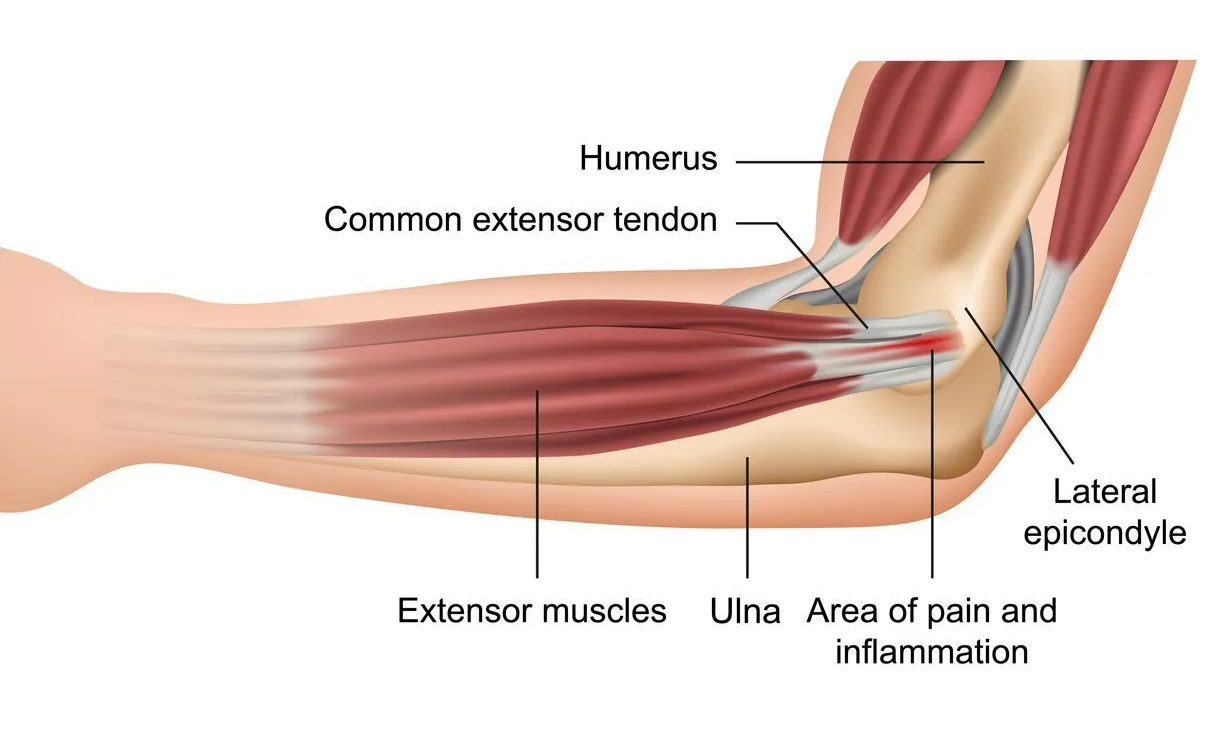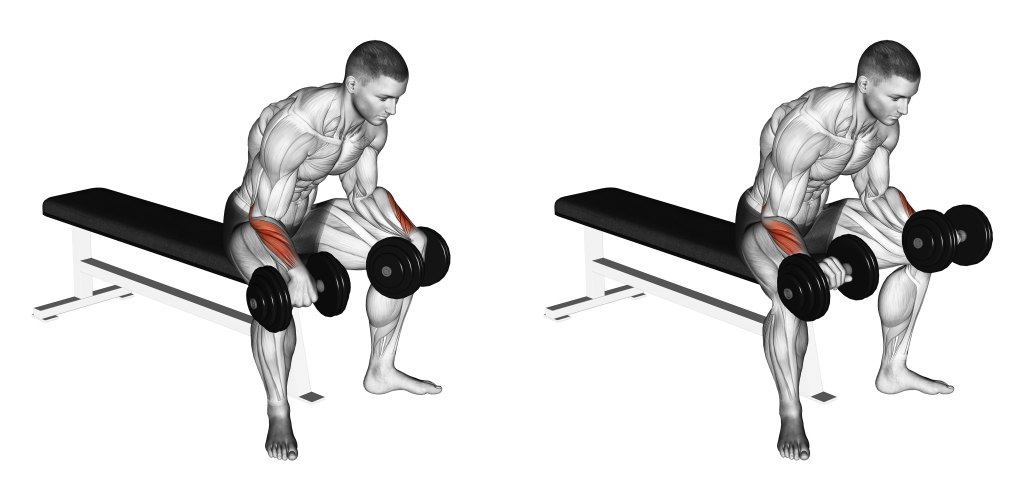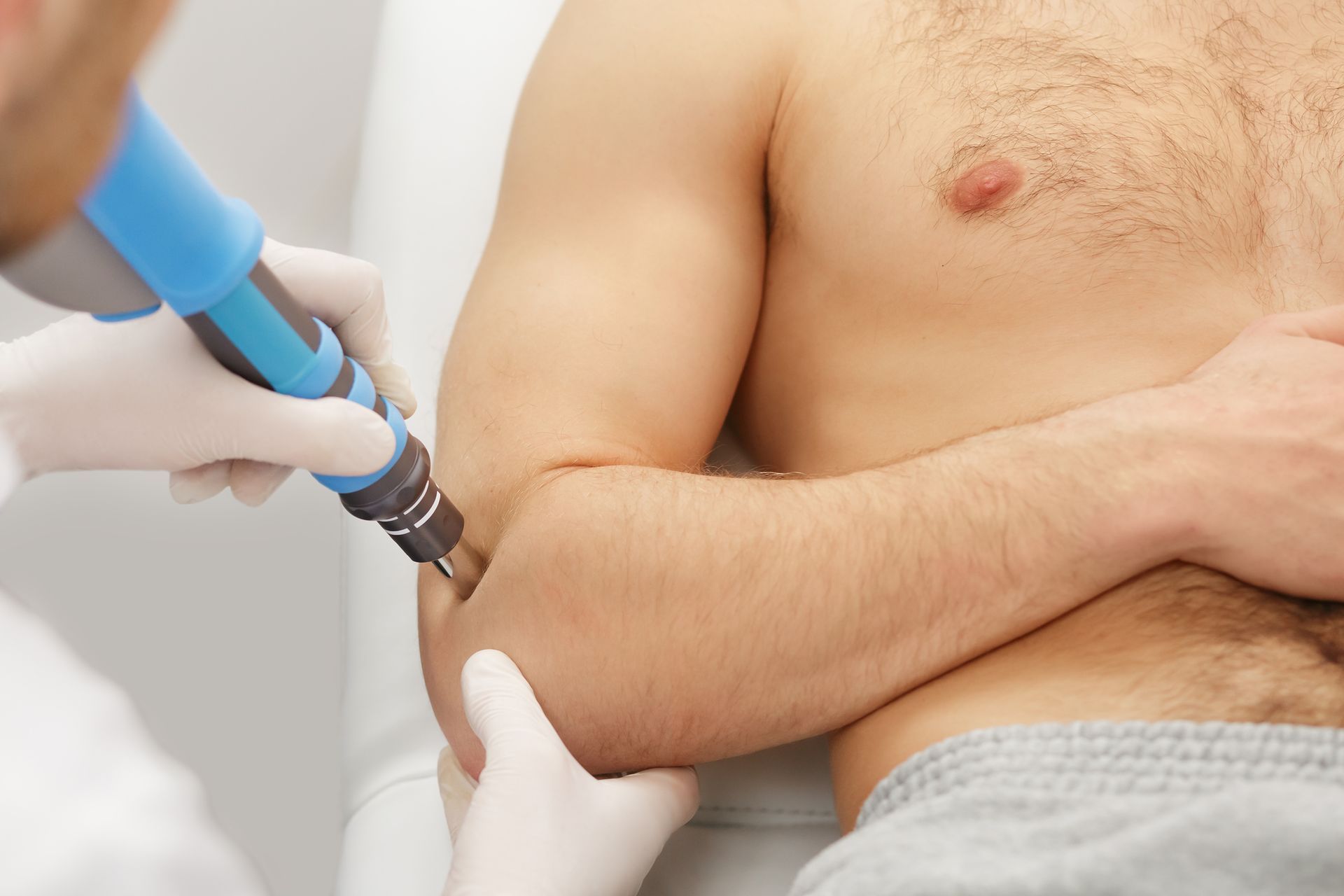What is Tennis Elbow?
Tennis elbow, also known as common extensor Tendinopathy and lateral epicondylalgia, is a very
common condition affecting the muscles and tendons that extend your fingers and wrist, causing
pain on the outside of the elbow. The pain is particularly aggravated when you grip objects and
play racquet sports. Pain can also spread into your forearm and wrist.
The pain is usually a dull ache or burning pain that is aggravated by activities involving gripping.
Despite the name, tennis elbow only affects a small percentage of tennis players. It is typically
caused by any activity that puts repeated stress on the muscles and tendons that attach on the
outside of the elbow joint, including painting, gardening, DIY, or even frequent computer use.
We will structure your treatment programme specifically to your goals and will support you through
the process from diagnosis to return to your activity or sport.

Anatomy for Tennis Elbow
The elbow joint is the point of articulation between the upper arm and the forearm. It is made up of
three bones, the humerus (upper arm bone) and the radius and ulna (the bones of the forearm).
The elbow joint is held together by ligaments, tendons and muscles, which all work in partnership
to provide mobility, stability, and strength to the elbow.
Your forearm muscles extend your wrist and fingers. Your forearm extensor tendons attach these
muscles to the bones in your elbow. The extensor tendons attach onto the bony bump on the
outside (lateral side) of the elbow (the lower part of your humerus) called the lateral epicondyle;
hence the condition also being known as lateral epicondylalgia. This is where the site of pain is.
The tendon usually involved in tennis elbow is called the extensor carpi radialis brevis (ECRB).
What causes Tennis Elbow?

It is an overuse injury; as the muscles of your wrist and hand repeatedly contract, it can cause a
strain on the tendon or tendons that attach onto the outer elbow (lateral epicondyle). This excess
strain results in minor tears in the tendon (microtrauma), which then becomes painful and inflamed.
Tendon irritation is often known as tendinitis or tendinopathy.
If the pain persists over a longer period of time (more than a few months), the problem can become
chronic which can make it more difficult to treat.
It almost always affects your dominant hand.
Common Causes of Tennis Elbow Include
- Unaccustomed activity and hand use, e.g. painting a fence, DIY, or excessive typing and mouse work.
- Activities or sports that involve excessive gripping.
- Muscle imbalances – weak forearm muscles or tight muscles.
- Poor stability and strength around the shoulder girdle.
- A poor technique i.e., a poor tennis or squash shot (usually back hand).
- Incorrect equipment i.e computer equipment, tennis/squash racquet or grip size.
Risk Factors for Tennis Elbow
There are several risk factors which may make you more susceptible to experiencing tennis elbow:
Age – It is most common in adults between 30 and 50 years old, though it does affect people of all
ages.
Occupation – It often affects typists or people who do a lot of computer work, painters, carpenters,
plasterers, plumbers, chefs, and other professions that require some degree of repeated motion in
the wrist and forearm.
Sport/Activity – It is more prevalent in those that play racket sports such as tennis and squash,
golf, and also in individuals that lift weights in the gym.

What Are The Symptoms of Tennis Elbow?
Typically someone suffering from tennis elbow will experience pain when performing gripping tasks
or resisted wrist/finger extension such as lifting a kettle, gripping weight and playing sports. There
will be tenderness directly over the outside of the elbow over the bony epicondyle, and there may
also be painful points in the muscles along the forearm. Pain can be present when the forearm
muscles are stretched and some people may also have neck stiffness and tenderness. Most elbow
movements will be pain-free (unless gripping hard at the same time), despite that being the area of
pain.
The symptoms of tennis elbow usually begin to appear gradually, as the condition is a progressive
one, rather than related to an acute injury. As the condition progresses, the associated pain
gradually increases over the course of a few weeks or months.
Common signs and symptoms of tennis elbow:
- Ache or burning pain on the outer elbow, gradually increasing over time.
- Reduced grip strength.
- Usually affects the dominant arm.
- Pain worsens with sports or activities that require gripping.
Pain is often also felt while performing basic actions, such as writing or when gripping
small objects, lifting a kettle, turning a door handle or opening a jar.
Tenderness to touch on the bone and muscles on the outside of the elbow.
Swelling on the outside of the elbow.
How do we Diagnose Tennis Elbow?
Obtaining an accurate diagnosis of tennis elbow is essential. It allows the clinician to select the
most effective treatment plan for you. A diagnosis will be made by your physiotherapist who will
carry out a comprehensive subjective and clinical assessment. It is not essential at this stage to
have a scan.
They will ask questions about your past health, symptoms, and exercise regime, which will give
your clinician a good indication of your diagnosis.
After your consultation, the specialist physio will complete a series of tests to help confirm a
diagnosis. This may include:
- Assessing the range of movement and strength of your wrist, elbow, and shoulder.
- Assessing your grip strength.
- Measuring muscle length and flexibility of your forearm and upper limb.
- Checking other regions of the body as needed, such as your neck, back and shoulder. This
will help to determine if other areas also require treatment to improve your condition.
Gently, but skillfully, feeling around your elbow and forearm, to find exactly where it is most painful.
- Functional tests – if your pain is present during a specific activity or task, you may be asked to
perform these, so the physiotherapist can assess exactly what is aggravating your pain.
There is a specific test called the “Mills test” which is an accurate clinical test for diagnosing tennis
elbow.
The clinical assessment is normally sufficient to diagnose tennis elbow. However, it is limited in
providing any further information about the exact structure of the tendon and surrounding tissues,
and the severity of the condition. This is where an ultrasound scan can be useful.
Diagnostic Ultrasound Scan for Tennis Elbow
A real-time diagnostic ultrasound scan will help to confirm the diagnosis of tennis elbow, ascertain
the severity of the problem and to check if you have a tear in your tendon. It provides more detail
than an MRI.
An ultrasound scan is able to clearly visualise the tendon structure and inflammation associated
with tendinopathy. It is regarded as the gold standard imaging technique for assessing tendon
structure and pathology, better than MRI.
An ultrasound scan showing tendinopathy indicating tennis elbow. An ultrasound scan is better
than an MRI scan for visualising the tendon.
The scan allows for accurate assessment of the severity of the problem and can aid in treatment
selection. Once a full diagnosis has been made, your clinician will be able to discuss the most
effective treatment options with you.
Treatment for Tennis Elbow?
Physiotherapy and rehabilitation for tennis elbow.
At the clinic we have treated a variety of patients with elbow pain, from Racing drivers, gymnasts to
recreational sports and women, and more sedentary individuals who get pain picking up objects.
Your physiotherapist at Chelmsford Physio will provide you with a personally tailored regime for
your tennis elbow, based on your clinical assessment.
Generic tennis elbow exercises, particularly those found on the internet do not help everyone! Your
programme must be tailored to your own personal goals. For example, the rehabilitation
programme for a professional tennis player will be different to a plasterer or brick layer, or
someone who wants to simply pick up the kettle or shopping bags with no pain.
This will often include:
Patient education – it is important to understand your condition and to be active in your recovery.
You will be given a clear explanation of the diagnosis, and we will discuss what is required to
address your symptoms and reach your goals.
Relative rest – advice on rest and activity modification allowing your elbow pain to settle and the
extensor tendon to heal. In severe cases, it might be that a wrist splint is required to allow the
forearm tendons to completely rest for a short period of time.
Pain management – ice applied to the affected area can be very effective in helping control pain
and inflammation. Over-the-counter medication such as painkillers and anti-inflammatories can
also ease pain and inflammation.
Specific loading/strengthening exercises – clinical research has shown that heavy slow
resistance (HSR) strengthening exercises can have a positive effect on tendinopathy. This is a key
component of your treatment programme and requires commitment and consistency. We are
specialists at exercise prescription and progression and will develop a bespoke programme for
you.

Range-of-movement exercise – your physiotherapist may teach you active, self-stretching
methods. They may also do some hands-on, passive stretching with you. Together, these can
really help decrease muscle tightness and tension and restore normal motion of your joints and
muscles.
Manual therapy – your physiotherapist may use manual therapy such as joint mobilisations and
soft tissue release techniques to the surrounding muscles. This will help improve movement and
reduce muscle stiffness or soreness
Muscle strength – muscle weaknesses or imbalances throughout the upper limb can cause or
contribute to problems with tennis elbow. Your physiotherapist will design a safe resistance
program to ensure all your muscle groups are strong and working in synergy to aid your recovery
and prevent recurrence of injury.
Functional and sports-specific training – once your pain, strength, and range of movement
improve, you can begin more demanding, sports-specific rehab.
What if physiotherapy treatment has not worked for your tennis elbow pain?
If physiotherapy options have been unsuccessful, there are a few other treatment modalities
available to you. It is important to remember that physiotherapy should always be the key
component of any tennis elbow treatment pathway, but we always appreciate that physiotherapy
alone does not get every patient better.
The good news is at Chelmsford we provide other treatment options that work in conjunction with
physiotherapy to improve your pain and help the tendon to heal.
Shockwave therapy and injection therapy can complement your rehabilitation programme and can
significantly reduce your pain and speed up your recovery.

At Chelmsford Physio we specialise in the rehabilitation of tendon complaints, both of the upper
limb and lower limb. We see and successfully treat hundreds of Tennis Elbow complaints in our
clinic every year.
If you have any questions or would like some further advice, please don’t hesitate to get in touch.
Thank you for reading!
Chelmsford Physio
Riverside Leisure Centre, Victoria Rd, Chelmsford CM1 1FG



